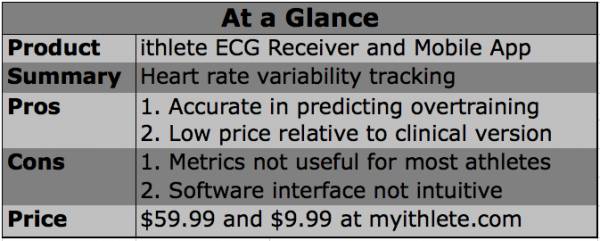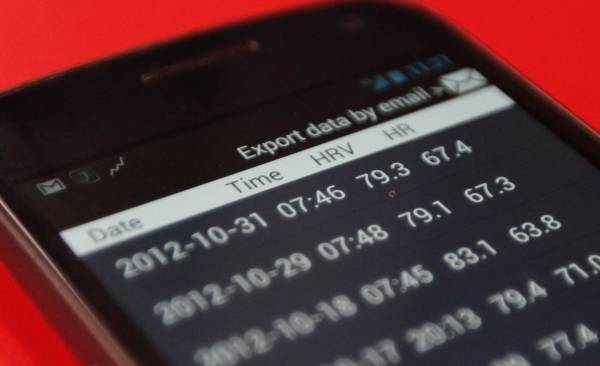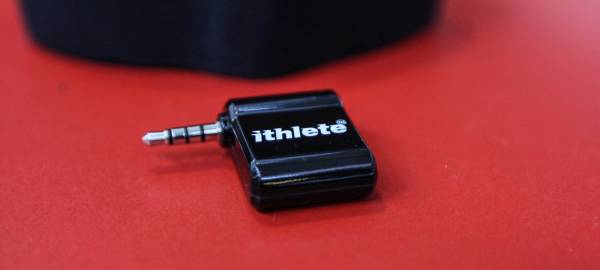
No pain, no gain. Right? I’d like to think most Breaking Muscle readers are already aware of the dangers of overtraining. There’s no better way to be completely counterproductive to one’s fitness goals, and knowing when to have a rest day is just as important as tracking your progress. Hell, progress and rest days are technically one in the same since rest is when your muscles rebuild. Yet despite the number of tools we have to scientifically track and measure how to workout, we still decide when to workout primarily with a calendar, completely unrelated to what our body is saying.
Your body, and more specifically, your heart, has a lot to say about your workout schedule. The ithlete ECG Receiver claims to accurately monitor and track you HRV (heart rate variability), in turn telling you exactly when it’s time to take a break or get back to the gym.
Drum Machines Have No Soul
(How Heart Rate Variability Tells Us if We’re Ready to Rock)
 Drummers detest drum machines for various, often amusing reasons, but primarily because it’s steady beat is too “perfect.” Well it turns out, our hearts have a little soul. A healthy athlete with a resting pulse of 40 beats per minute is actually drumming at a variation of that oversimplified number, a variation that is now becoming easier to measure thanks to advances in technology. This perfect little imperfection gives us insight into critical information about the function of our autonomic nervous system. Information such as our current physical, chemical, and psychological condition.
Drummers detest drum machines for various, often amusing reasons, but primarily because it’s steady beat is too “perfect.” Well it turns out, our hearts have a little soul. A healthy athlete with a resting pulse of 40 beats per minute is actually drumming at a variation of that oversimplified number, a variation that is now becoming easier to measure thanks to advances in technology. This perfect little imperfection gives us insight into critical information about the function of our autonomic nervous system. Information such as our current physical, chemical, and psychological condition.
Normal HRV values range from 50-100 – the higher the number, or the more variability, the better. When your variability drops, it means you could be overtrained. It should be noted this number is highly dependent on the individual, so you won’t find much value out of comparing numbers with others. Your baseline is your personal point of reference.
How Does the ithlete ECG Receiver Work?
 In order to record your HRV, you’ll need to purchase and download the ithlete software onto your iOS or Android device. Plug the ithlete ECG Receiver into your device’s headphone port. Strap on a compatible 5.4 KHz analog standard pulse reading chest strap. Hit start while in the “Measure” tab and begin to breath deeply, keeping pace with the lung animation on screen. Do this every morning as you wake up, before you have coffee. After a few days, you’ll have yourself a baseline sample. (Note: there are no directions in the software or hardware in regards to exercise during these first days, so my advice is take it easy activity-wise so your baseline is actually a proper baseline.)
In order to record your HRV, you’ll need to purchase and download the ithlete software onto your iOS or Android device. Plug the ithlete ECG Receiver into your device’s headphone port. Strap on a compatible 5.4 KHz analog standard pulse reading chest strap. Hit start while in the “Measure” tab and begin to breath deeply, keeping pace with the lung animation on screen. Do this every morning as you wake up, before you have coffee. After a few days, you’ll have yourself a baseline sample. (Note: there are no directions in the software or hardware in regards to exercise during these first days, so my advice is take it easy activity-wise so your baseline is actually a proper baseline.)
Once you have a baseline, the app begins to give you advice. A common HRV for a fit 40-50 year old male, for example, could land in the 82 range. If that range begins to drop significantly after a few days of working out, the ithlete software will indicate it’s time to take a break by a falling red line. If the falling line is amber, you might want to do a lighter workout that day. Once your HRV recovers to a variation closer to your baseline with a climbing blue or green line, it’s time to get back to work. You’ll also have a trending blue line that averages the day-to-day changes.
Pros
The overall accuracy of the chart is stunning. I’m not talking about the individual HRV values, since I don’t have any other device to confirm reading. I’m talking about the feeling of an overstressed body on days when my baseline value had dropped. I have, unfortunately, been victim to overtraining in the past and have a good sense of when it’s time to take time off. I attempted to overdo it for a week in order to see if I could move the needle down. FOR SCIENCE!!!
I typically left the receiver and chest strap on my nightstand so I would get in the habit of recording a daily reading. By far, the best part about the ECG is its price point relative to what it would cost to measure these values in a clinic. A complete kit will run you $100. And yet…
Cons
 The price point is indeed relative. Relative to metrics I personally wouldn’t pay for in the first place. So to most athletes, this is an expensive software/hardware purchase that does one thing. Morning ECG measurements. The software and receiver do not (currently) act as a more common heart rate monitor.
The price point is indeed relative. Relative to metrics I personally wouldn’t pay for in the first place. So to most athletes, this is an expensive software/hardware purchase that does one thing. Morning ECG measurements. The software and receiver do not (currently) act as a more common heart rate monitor.
The software interface doesn’t fall into the intuitive pool of iOS and Android apps. For example the first few days of recording your HRV don’t track any information. The software is actually in the process of collecting your baseline, but it doesn’t let you know. It took quite a bit of research to understand how to go about collecting HRV data. While learning how it feels to be overtrained could be a useful exercise for novice athletes, this device is just not user friendly enough for me to recommend it for that purpose.
By far, the biggest con to using HRV data to dictate workouts is the fact the HRV, as mentioned earlier, measures more than physical stress. It’s also capable of measuring physiological stress, among many other things, which could lower your HRV. Thus, in theory, your stress level can tell ECG you shouldn’t workout, when a good workout might just do you some good.
Final Thoughts
 The ithlete ECG Receiver is a powerful little tool for advanced athletes. This niche information however feels a bit overpriced. The hardware price point is quite fair, but at $9.99 the software needs some help from an experienced user interface designer. My personal reservations about using HRV as a physical health indicator are pretty much nullified by the thousands of peer reviewed articles on the subject. I recommend the device to top tier athletes who have money to spare, otherwise I recommend holding off until we see future iterations of the software.
The ithlete ECG Receiver is a powerful little tool for advanced athletes. This niche information however feels a bit overpriced. The hardware price point is quite fair, but at $9.99 the software needs some help from an experienced user interface designer. My personal reservations about using HRV as a physical health indicator are pretty much nullified by the thousands of peer reviewed articles on the subject. I recommend the device to top tier athletes who have money to spare, otherwise I recommend holding off until we see future iterations of the software.
Reviewed Software Version
Android 2.0 on Samsung Galaxy Nexus
Product Info
ithlete Heart Rate Variability App – $9.99
ithlete ECG Receiver – $59.99
Chest Strap Monitor and ECG Receiver Combo – $94.99






